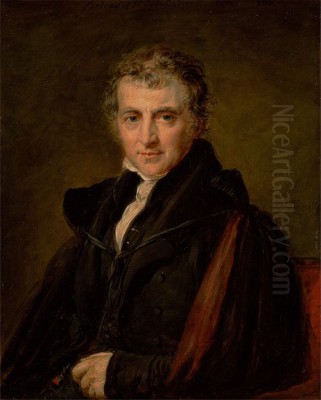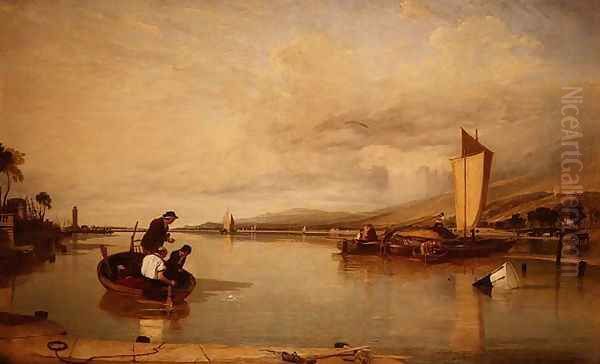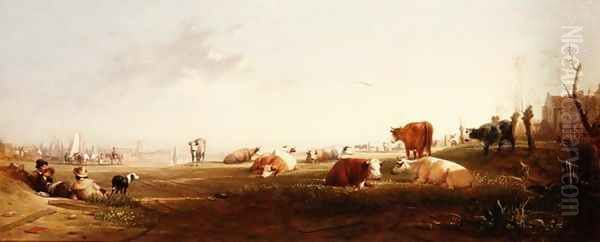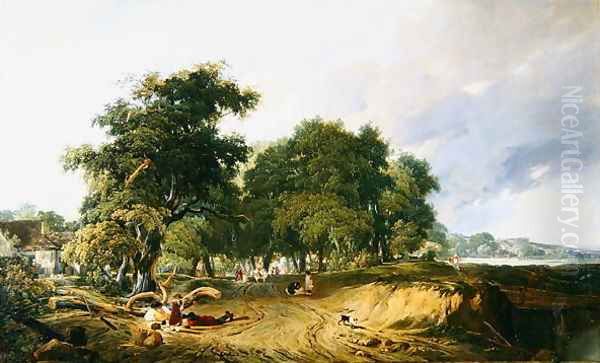
Sir Augustus Wall Callcott, a distinguished figure in the annals of British art, carved a significant niche for himself as a landscape painter during the vibrant artistic period of the late 18th and early 19th centuries. Born in 1779 in the then semi-rural enclave of Kensington Gravel Pits, London, and passing away in 1844, Callcott's life and career spanned a transformative era in British art. He was celebrated for his serene and classically composed landscapes, earning him the laudatory epithet "the English Claude," a comparison to the great French Baroque master Claude Lorrain, whose idealized landscapes set a standard for centuries. Callcott's journey from a promising musician to a knighted painter and a custodian of the Royal Collection is a testament to his dedication, talent, and the high esteem in which he was held by his contemporaries and patrons, including the Crown itself.
Early Life and a Pivotal Shift to Art
Augustus Wall Callcott's initial path seemed destined for music rather than the visual arts. He was the younger brother of the accomplished musician and composer Dr. John Wall Callcott, a prominent figure in London's musical circles. Following in his family's artistic inclinations, Augustus began his career in music, serving for several years as a chorister at the prestigious Westminster Abbey. This early immersion in the world of harmony and composition perhaps subtly informed his later approach to painting, lending a sense of balance and rhythm to his visual works.
However, the allure of the canvas proved stronger than that of the musical score. Around the age of twenty, Callcott made a decisive career change, abandoning his musical pursuits to dedicate himself entirely to painting. This was not a decision taken lightly, but it marked the true beginning of his artistic journey. He sought formal training at the esteemed Royal Academy Schools, the preeminent institution for art education in Britain at the time. His tutelage under John Hoppner RA, a leading portrait painter of the day, provided him with a solid foundation in painterly technique and academic principles. Hoppner, a rival to Sir Thomas Lawrence, was known for his elegant and fashionable portraits, and Callcott initially followed this path.
From Portraits to Poetic Landscapes

Callcott's early artistic endeavors focused on portraiture, a genre in which his master, John Hoppner, excelled. He exhibited his first work at the Royal Academy in 1799, likely a portrait, demonstrating his proficiency in capturing likenesses. However, his true passion lay elsewhere. Gradually, Callcott found himself increasingly drawn to the evocative power of landscape painting, a genre that was gaining unprecedented popularity and prestige in Britain, championed by artists like Richard Wilson before him and his contemporaries J.M.W. Turner and John Constable.
His transition to landscape painting was not abrupt but a considered evolution. He began to explore the nuances of the British countryside and coastline, developing a style characterized by its classical compositional schemes, often imbued with a serene and sometimes melancholic atmosphere. His landscapes were noted for their careful arrangement of elements, a harmonious balance of light and shadow, and a poetic sensibility that resonated with the Romantic spirit of the age, yet always tempered by a classical restraint. This distinguished his work from the more overtly dramatic or naturalistic approaches of some of his peers.
The "English Claude": Influences and Artistic Style
The moniker "English Claude," frequently applied to Callcott, highlights a crucial aspect of his artistic identity: his deep admiration for and emulation of the 17th-century French master Claude Lorrain. Claude's idealized landscapes, with their luminous skies, classical ruins, and carefully constructed perspectives, were the benchmark for picturesque beauty. Callcott, like many British landscape painters of his generation, including Richard Wilson who was perhaps the first to truly anglicize Claude's style, sought to capture a similar sense of timeless elegance and harmony in his depictions of both British and continental scenery.
Beyond Claude, Callcott was significantly influenced by 17th-century Dutch landscape painters. His two documented visits to Holland, in 1818 and 1824, were pivotal. He meticulously studied the works of masters such as Aelbert Cuyp, renowned for his golden-hued depictions of Dutch river scenes, Jacob van Ruisdael, with his dramatic skies and wooded landscapes, and Meindert Hobbema, famed for his tranquil village scenes. This Dutch influence is particularly evident in Callcott's coastal and river scenes, where he masterfully rendered the effects of light on water and the bustling activity of ports, often with a focus on architectural features and urban settings rather than purely rural life. His painting Entrance to the Pool of London, exhibited at the Royal Academy in 1816, drew direct and favorable comparisons with Cuyp's Dort, underscoring his success in this vein.

Callcott's style, therefore, was a sophisticated amalgamation. It combined the classical idealism of Claude with the atmospheric realism and meticulous detail of the Dutch school, all filtered through his own distinctly British sensibility. His compositions were often carefully structured, sometimes featuring classical or mythological figures, as seen in works like Winter or The Saturnalia and Spring or Worship of Juno Lucina. These paintings, with their allegorical themes, demonstrate his ambition to elevate landscape painting beyond mere topography to a more intellectual and poetic plane, akin to history painting in its moral and narrative weight.
Key Works and Thematic Concerns
Throughout his prolific career, Callcott produced a significant body of work that showcased his distinctive style. His landscapes often depicted coastal scenes, river estuaries, and tranquil inland views. Sheerness and the Isle of Sheppey is one such example, capturing the particular light and atmosphere of the Kentish coast. His Dutch-inspired works, such as Rotterdam Harbour and View of Amsterdam, are celebrated for their detailed rendering of shipping and architecture, and their evocation of the maritime life of the Low Countries.
A notable work, Dead calm, boats off Cowes Castle, exhibited at the Old Water-Colour Society in 1827, demonstrates his skill in capturing serene maritime conditions. His paintings often featured a calm, reflective quality, emphasizing tranquility and order. While influenced by J.M.W. Turner, particularly in the handling of light and atmosphere, Callcott's work generally maintained a greater degree of compositional clarity and a less tumultuous emotional range than his more famous contemporary. He was less concerned with the sublime and more with the picturesque and the beautifully ordered. His focus on architectural elements within his landscapes also set him apart, lending a sense of structure and human presence to his natural scenes.
Recognition and Royal Patronage
Callcott's artistic achievements did not go unnoticed by the art establishment or by royalty. He was elected an Associate of the Royal Academy (ARA) in 1806, a significant early recognition of his talent. Just four years later, in 1810, he achieved the status of full Royal Academician (RA), cementing his position among the leading artists of his day. This was a period when the Royal Academy, under presidents like Benjamin West and later Sir Thomas Lawrence, was the undisputed center of the British art world.

His reputation continued to grow, culminating in a knighthood conferred upon him by Queen Victoria in 1837. This honor was a clear indication of his high standing not only within artistic circles but also in broader society. The royal favor extended further when, in 1843, Sir Augustus Wall Callcott was appointed Surveyor of the Queen's Pictures (also referred to as Conservator of the Royal Pictures). This prestigious role entrusted him with the care and oversight of the vast and historically significant Royal Collection of artworks, a position previously held by distinguished figures and one that underscored the Queen's personal confidence in his judgment and expertise. This appointment, coming late in his career, was a fitting capstone to his decades of artistic endeavor.
Interactions with Contemporaries and Artistic Circles
Callcott was an active participant in the London art scene. His relationship with J.M.W. Turner was complex, marked by both rivalry and mutual respect. They were leading figures in landscape painting, and their works were often exhibited alongside each other at the Royal Academy, inviting comparisons. While Turner's genius was perhaps more revolutionary and far-reaching, Callcott held his own as a master of a more classical and serene mode of landscape. He was also a contemporary of John Constable, another giant of British landscape painting, whose naturalistic approach offered a different vision of the British countryside. Though Callcott's originality was sometimes considered secondary to these two titans, his skill and the distinct appeal of his work were widely acknowledged.
He was a student of John Hoppner, and this early connection to a prominent portraitist shaped his initial training. Callcott was also involved with artistic societies beyond the Royal Academy. He was a member of the "Associated Artists in Water Colours," a society founded in 1807 to provide an exhibition platform for artists working in watercolor, particularly those not part of the older Society of Painters in Water Colours (often called the Old Water-Colour Society, where he also exhibited). This involvement indicates his engagement with the burgeoning watercolor movement, a medium in which British artists excelled.
His social and familial connections also played a role in his life. His brother, Dr. John Wall Callcott, was a respected musician. Later in life, in 1827, Augustus Callcott married Maria Graham (née Dundas), a writer and traveler, and the widow of Captain Thomas Graham RN. Maria Graham was an accomplished figure in her own right, an author of travelogues and children's books, and an art historian who published on early Italian painting, sometimes illustrated by Callcott himself. Her intellectual companionship undoubtedly enriched his later years. She was also a friend of artists like Charles Lock Eastlake, who would later become Director of the National Gallery.
Later Career, Legacy, and Historical Evaluation
Sir Augustus Wall Callcott continued to paint and exhibit throughout his life, maintaining a consistent level of quality and refinement in his work. His appointment as Surveyor of the Queen's Pictures in 1843, though it came just a year before his death, was a significant acknowledgment of his lifelong dedication to art. He passed away on November 25, 1844, at the age of 65, in his native Kensington.
In the immediate aftermath of his death and for some decades following, Callcott's reputation remained high. He was seen as one of the triumvirate of great British landscape painters of his era, alongside Turner and Constable. However, as artistic tastes shifted in the later 19th and 20th centuries, with a greater emphasis on avant-garde movements and a re-evaluation of Romanticism, Callcott's more classical and restrained style perhaps saw his fame somewhat eclipsed by the more overtly innovative Turner and the profoundly influential Constable. Artists like John Martin, with his dramatic apocalyptic scenes, or David Roberts and Clarkson Stanfield, with their respective focuses on architectural views and marine subjects, also carved out distinct niches that perhaps overshadowed Callcott's quieter contributions for a time.
Despite this, art historians have continued to recognize Sir Augustus Wall Callcott's significant contributions. His ability to synthesize the influences of Claude Lorrain and the Dutch masters into a distinctly British form of landscape painting was a considerable achievement. His works are admired for their technical skill, their serene beauty, and their embodiment of a particular early 19th-century aesthetic that valued harmony, order, and a poetic engagement with nature. His paintings can be found in major public collections, including the Tate Britain, the Victoria and Albert Museum, and the Royal Collection, ensuring his enduring presence in the narrative of British art. He remains an important figure for understanding the breadth and depth of landscape painting in Britain during a period of its greatest flourishing.
Conclusion: An Enduring Contribution
Sir Augustus Wall Callcott stands as a pivotal figure in the rich tapestry of British landscape art. From his early musical inclinations to his celebrated career as a painter, his life was one of artistic dedication and achievement. His ability to absorb and reinterpret the grand traditions of Claude Lorrain and the Dutch Golden Age masters, while forging a style that was recognizably his own, earned him accolades during his lifetime, including a knighthood and a significant role in the Royal Household.
While perhaps not possessing the revolutionary fervor of Turner or the earthy naturalism of Constable, Callcott's landscapes offer a vision of serene, ordered beauty, characterized by masterful composition, subtle atmospheric effects, and a deep appreciation for the interplay of light, water, and architecture. His works, from the tranquil shores of Sheerness to the bustling ports of Holland, continue to resonate with viewers, offering a window into the refined sensibilities of early 19th-century Britain. As the "English Claude," he successfully translated a continental ideal into a British idiom, contributing significantly to the golden age of landscape painting in his homeland and leaving behind a legacy of elegant and enduring art. His influence can be seen in the work of subsequent landscape painters who valued classical structure and poetic sentiment, ensuring his place in the continuing story of art.